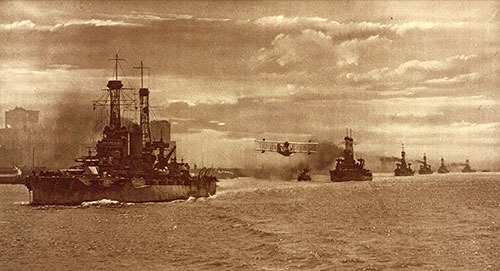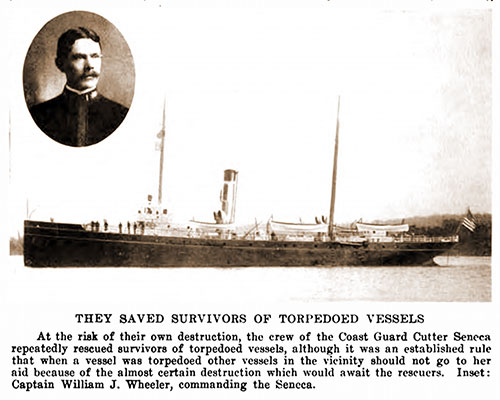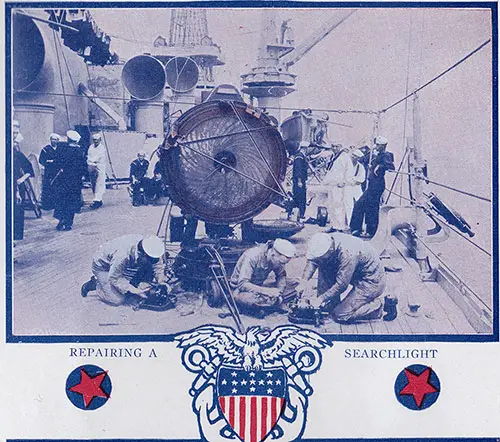2,000 Vessels in Service When War Ended - 1919

Greatest United States Naval Fleet Ever Assembled in American Waters. American Dreadnoughts and Superdreadnoughts Steaming into New York Harbor April 14, 1919. Photograph © Paul Thompson. The War of the Nations, New York Times, 1919. GGA Image ID # 196344f8bd
The growth of the Navy in ships and personnel was phenomenal. When the war began, there were 364 vessels on the naval list, of which 20 were listed as unserviceable for war purposes. When the armistice was signed, the Navy was manning and operating 2,000 vessels, including those of all classes, large and small. Following is a list of the naval vessels then in service:
Fit for Service, Including Those Under Repair
- Battleships, single caliber: 16
- Battleships, mixed caliber: 23
- Battle cruisers: 0
- Armored cruisers: 8
- Monitors: 7
- Cruisers, first class: 4
- Cruisers, second class: 4
- Cruisers, third class: 15
- Destroyers: 92
- Coast torpedo vessels: 15
- Torpedo boats: 17
- Submarines: 79
- Tenders: 17
- Gunboats: 37
- Transports: 5
- Supply ships: 5
- Hospital ships: 6
- Fuel Ships: 21
- Converted yachts: 12
- Patrol vessels: 2
- Submarine chasers: 300
- Mine sweepers: 14
- Tugs: 50
- Special type: 13
- Unserviceable for War Purposes: 15
Total: 777
Under construction and authorized
- Battleships, single caliber: 13
- Battleships, mixed caliber: 0
- Battle cruisers: 6
- Armored cruisers: 0
- Monitors: 0
- Cruisers, first class: 0
- Cruisers, second class: 10
- Cruisers, third class: 0
- Destroyers: 250
- Coast torpedo vessels: 0
- Torpedo boats: 0
- Submarines: 102
- Tenders: 3
- Gunboats: 2
- Transports: 1
- Supply ships: 0
- Hospital ships: 1
- Fuel Ships: 3
- Converted yachts: 0
- Patrol vessels: 98
- Submarine chasers: 42
- Mine sweepers: 40
- Tugs: 81
- Special type: 3
- Unserviceable for War Purposes: 0
Total: 655
Total Ships
- Battleships, single caliber: 29
- Battleships, mixed caliber: 23
- Battle cruisers: 6
- Armored cruisers: 8
- Monitors: 7
- Cruisers, first class: 4
- Cruisers, second class: 14
- Cruisers, third class: 15
- Destroyers: 342
- Coast torpedo vessels: 15
- Torpedo boats: 17
- Submarines: 181
- Tenders: 20
- Gunboats: 39
- Transports: 6
- Supply ships: 5
- Hospital ships: 7
- Fuel Ships: 24
- Converted yachts: 12
- Patrol vessels: 100
- Submarine chasers: 342
- Mine sweepers: 54
- Tugs: 131
- Special type: 16
- Unserviceable for War Purposes: 15
Total: 1,432
In addition, the Navy was manning 50 troop transports, 232 cargo transports, 640 patrol vessels in the district, 175 barges in districts, and a number of other miscellaneous craft.
Force of 619,000 Officers and Men

They Saved Survivors of Torpedoed Vessels. At the risk of their own destruction, the crew of the Coast Guard Cutter Seneca repeatedly rescued survivors of torpedoed vessels, although it was an established rule that when a vessel was torpedoed other vessels in the vicinity should not go to her aid because of the almost certain destruction which would await the rescuers. Inset: Captain William J. Wheeler, commanding the Seneca. Our Navy at War, 1922. GGA Image ID # 180437f175
The growth in personnel was even more notable. When the armistice was signed, there were 619,449 men and officers in the service, as follows:
Enlisted Men
- Regular Navy: 216,644
- Naval Reserve Force: 290,963
- Marine Corps: 70,527
- Coast Guard: 5,705
Total: 583,839
Officers
- Regular Navy: 10,467
- Naval Reserve Force: 21,985
- Marine Corps: 2,435
- Coast Guard: 723
Total: 35,610
In Total
- Regular Navy: 227,111
- Naval Reserve Force: 312,948
- Marine Corps: 72,962
- Coast Guard: 6,428
Total: 619,449

Sailors Repairing a Searchlight, Our Navy's Part in the Great War, 1919. GGA Image ID # 17fa4a5971
In addition, more than 80,000 mechanics and other workmen were employed in Navy Yards, and there were several thousand other civilian employees under the Department engaged in various duties. So that there were more than 700,000 persons in the Naval Establishment, ashore and afloat.
When the war was declared, April 6, 1917, there were:
- in the Navy 64,680 enlisted men and 4.366 officers; total, 69,046
- in the Marine Corps, 13,266 enlisted men and 426 officers; total, 13,692
Some 10,000 had been enrolled in the Naval Reserve Force; the 10,000 officers and men of the Naval Militia were mustered into the Federal service as National Naval Volunteers, and the Coast Guard, with its 4,500 officers and men, came under the operation of the Navy for the period of the war.
Wide Scope of Navy's Operations
The United States Navy's operations covered the widest scope in its history, extending from the Murman coast of Russia and the North Sea to the Mediterranean and the Adriatic; from Canada to Smith American waters; from the Pacific Coast to Vladivostok.
From our entrance into the war, it patrolled our vast extent of coasts and took over most of the patrol of the Western Atlantic. The Pacific Squadron, commanded by Admiral William B. Caperton, visited Rio de Janeiro, Buenos Aires, and Montevideo, cementing the friendship of our South American neighbors.
The vessels of the Asiatic Station, under Admiral Austin M. Knight, co-operated with the Japanese and our other allies in Oriental waters and took part in the allied activities at Vladivostok. The German High Seas Fleet being penned in its home ports, there was little opportunity for action on the part of major vessels.
The main body of the Atlantic Fleet, commanded by Admiral Henry T. Mayo, was held in home waters, protected against torpedo attack. It was kept in a high state of efficiency, ready for any call to action. Each ship was utilized as a training school in gunnery and engineering, and hundreds of gunners, engineers, and men in other lines were trained and sent out to man new vessels.
Great Work in Training Recruits
Within little more than a year, the personnel of the Naval service grew to a force of half a million. To house and train these recruits, a score of new camps and stations were erected, each a little city in itself, and numerous schools were established to train men in special branches. Sir Eric Geddes, First Lord of the British Admiralty, said of this:
"The dauntless determination which the United States has displayed in creating a huge, trained body of seamen out of landsmen is one of the most striking accomplishments of the war. Had it not been effectively done; one would have thought it impossible."
John Wilber Jenkins, Our Navy's Part in the Great War, New York: John H. Eggers Company, Inc., 1919, pp. 41-42.
